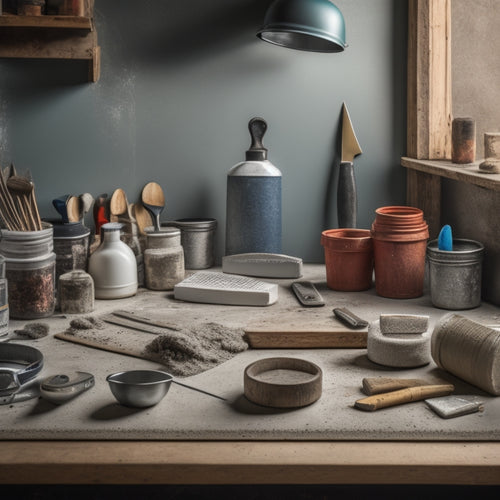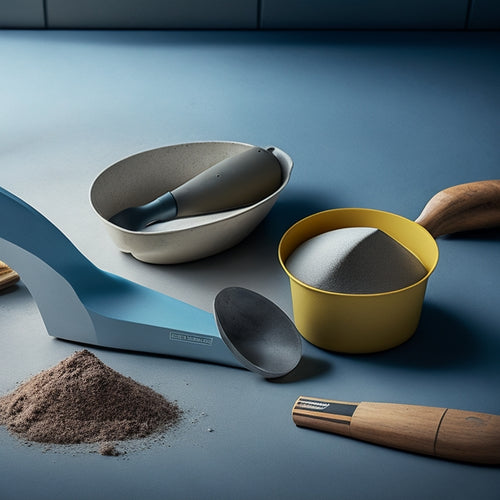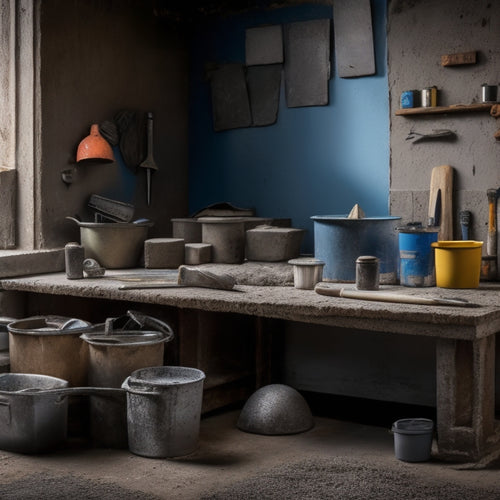
Top Tools for Successful Concrete Block Projects
Share
You'll need a range of specialized tools to guarantee a successful concrete block project, from essential hand tools like levels and trowels to specialized equipment like block splitters and concrete mixers. For cleaning, stiff-bristled brushes, clean water buckets, and scrapers are a must. When mixing and laying block, mechanical mixers, spirit levels, and dividing the project into sections will help you maintain consistency. Safety gear like sturdy gloves, safety glasses, and dust masks are also vital. With the right tools and equipment, you'll be well on your way to a professional-looking concrete block project, and understanding how to use them effectively will make all the difference.
Key Takeaways
• Essential hand tools like levels and trowels ensure alignment and precision in concrete block construction.
• Specialized equipment like block splitters and concrete mixers save time and effort in large-scale projects.
• Quality cleaning tools, such as stiff-bristled brushes and scrapers, are necessary for removing excess mortar and debris.
• Accurate cutting and shaping tools, including masonry saws and block chisels, help achieve professional finishes.
• Safety gear, including sturdy gloves and safety glasses, protects workers from injuries and hazards during block handling.
Best Tools for Cinder Block Construction
You'll need a combination of essential hand tools and specialized equipment to guarantee a successful cinder block construction project. When it comes to block design techniques, having the right tools can make all the difference. A level, for instance, guarantees your blocks are aligned perfectly, while a spirit level helps you achieve precise angles. A quality trowel is also crucial for applying the correct amount of mortar.
In addition to these hand tools, you may want to think about investing in specialized equipment like a block splitter or a concrete mixer. These tools can save you time and effort, allowing you to focus on more complex aspects of your project.
If you're looking for cinder block alternatives, you might contemplate using insulated concrete forms (ICFs) or autoclaved aerated concrete (AAC) blocks. These options offer improved thermal insulation and can be used to build structures that are more energy-efficient.
Essential Tools for Block Cleaning
As you prepare to clean your concrete blocks, you'll need the right tools to get the job done efficiently.
You'll want to focus on removing excess mortar and brushing away debris to guarantee a smooth surface.
To achieve this, you'll need to equip yourself with the essential tools that can tackle these specific tasks.
Remove Excess Mortar
Clean away excess mortar from the concrete blocks using a stiff-bristled brush or a wire scrub brush, working from the top down to prevent mortar from spreading to clean areas. This is a vital step in ensuring a professional finish and preventing damage to the blocks. Effective cleanup methods are essential to achieve a smooth, even surface.
When it comes to mortar removal techniques, you'll want to have the right tools at your disposal. Here are some must-haves:
-
A stiff-bristled brush or wire scrub brush for scrubbing away excess mortar
-
A bucket of clean water for rinsing away debris
-
A soft-bristled brush for gentle scrubbing and cleaning
-
A scraper or trowel for removing large chunks of mortar
-
A dustpan and broom for sweeping away debris and dust
Brush Away Debris
Brush Away Debris
Use a stiff-bristled brush or wire scrub brush to aggressively brush away debris and loose mortar from the concrete blocks, working from top to bottom to prevent re-depositing debris onto clean surfaces. This essential step in block maintenance guarantees a strong bond between the blocks and fresh mortar.
As you brush, focus on removing loose particles, dirt, and excess mortar that can compromise the structural integrity of your project. For efficient debris removal, choose a brush with sturdy bristles that can withstand the rough texture of concrete. A wire scrub brush is particularly effective at dislodging stubborn debris, but be cautious not to scratch the block surfaces.
Work methodically, brushing each block clean before moving on to the next. This attention to detail will pay off in the long run, as a clean surface guarantees a stronger, more durable structure. By brushing away debris, you'll set yourself up for success in your concrete block project.
Mixing and Laying Block Efficiently
You'll need to prepare a consistent mix and lay blocks swiftly to maintain the structural integrity of your concrete block project. Efficient mortar mixing and block setting are essential to achieving a strong and durable structure. To achieve this, focus on the following key aspects:
Mortar mixing: Use a mechanical mixer or a mixing stick to guarantee a consistent mix. Start with the right ratio of cement to sand, and gradually add water while mixing. Aim for a workable mix that's not too dry or too wet.
Block setting: Begin by laying a level course, using a spirit level to verify accuracy. Apply a layer of mortar to the block, and then press it firmly into place. Use a rubber mallet to tap the block into position, and check for level and plumb.
Work in sections: Divide your project into manageable sections, and complete each one before moving on to the next. This will help you maintain consistency and avoid mistakes.
Use the right tools: Invest in a mortar hawk, trowel, and level to make the mixing and laying process more efficient.
Keep it clean: Regularly clean your tools and mixing area to prevent mortar from setting and making a mess.
Cutting and Shaping Block Accurately
With your blocks laid efficiently, it's important to focus on cutting and shaping them to fit your project's specific requirements, ensuring a precise fit and a professional finish.
You'll need to master various block cutting techniques to achieve accurate cuts. One popular method is using a masonry saw, which offers precise control and clean cuts. Alternatively, you can use a circular saw with a diamond blade or a reciprocating saw with a masonry bit. Each technique has its advantages, so it's vital to choose the right tool for the job.
When it comes to shaping tools, a comparison of options is significant. You'll need to decide between a block chisel, a hammer and chisel, or a specialized block shaping tool. A block chisel is ideal for removing small amounts of material, while a hammer and chisel provide more force for larger cuts.
Specialized block shaping tools, like a block splitter, offer a high degree of precision and control. By selecting the right cutting and shaping tools, you'll be able to achieve precise fits and a professional finish, elevating the overall quality of your concrete block project.
Block Laying and Alignment Tools
Lay blocks accurately and efficiently by employing the right tools, which enable you to achieve precise alignment and a solid foundation for your concrete block project. When it comes to block laying and alignment, having the correct tools is essential for a successful project. By using innovative tools, you can guarantee that your blocks are properly aligned, leveled, and securely in place.
To achieve precise alignment, consider the following tools:
-
Alignment laser tools: These tools project a level line or dot onto the surface, guaranteeing your blocks are perfectly aligned.
-
Block leveling techniques: Utilize a spirit level or laser level to guarantee your blocks are level and plumb.
-
Block laying trowels: These trowels are specifically designed for laying blocks, allowing for smooth and even application of mortar.
-
String lines: These lines help you maintain a straight line, guaranteeing your blocks are aligned and evenly spaced.
-
Block alignment clamps: These clamps hold blocks in place, allowing you to make precise adjustments and guaranteeing a solid bond.
Safety Gear for Block Handling
As you move on to handling concrete blocks, prioritize your safety by equipping yourself with the right gear to prevent injuries and guarantee a secure working environment. Block handling safety is vital, and investing in personal protective equipment (PPE) is a must.
Start with a sturdy pair of gloves that provide grip and protection from abrasion and punctures. Safety glasses or goggles will shield your eyes from debris and concrete dust. A dust mask or respirator will prevent inhalation of harmful particles. Steel-toed boots with slip-resistant soles will keep your feet safe from heavy blocks and slippery surfaces.
Additionally, consider wearing a hard hat, especially when working with heavy blocks or at heights. Don't forget to wear long sleeves and pants to prevent skin exposure to concrete dust and debris.
Make sure your PPE fits properly and is in good condition to maximize its effectiveness. By wearing the right gear, you'll be well-protected and confident to tackle your concrete block project.
Frequently Asked Questions
Can I Use a Hammer Drill for Mixing Concrete?
You're wondering if you can use a hammer drill for mixing concrete? While it's technically possible, it's not the most efficient or effective approach.
Hammer drills are designed for drilling, not mixing, and can lead to uneven consistency and poor mixing results.
Instead, consider alternatives like a concrete mixer or a drill with a mixing paddle attachment.
Mastering various mixing techniques, such as the 'slump test,' will also guarantee a stronger, more durable concrete mix.
How Often Should I Lubricate My Block Cutting Saw?
When it comes to your block cutting saw, you'll want to prioritize regular lubrication to guarantee peak performance and longevity.
You should lubricate the saw every 1-2 weeks, depending on usage, using a high-quality lubricant specifically designed for saw maintenance.
Proper lubrication techniques involve applying a thin, even layer to the blade and guide rails, then wiping off excess with a clean cloth.
This routine will keep your saw running smoothly and accurately.
Are Concrete Blocks Suitable for Building Load-Bearing Walls?
When building load-bearing walls, you need to guarantee the materials can handle the weight.
Concrete blocks are a suitable choice, but you must consider their load-bearing capacity. The blocks' compressive strength, density, and mortar joint quality all impact wall stability.
You'll want to select blocks with a high compressive strength and follow proper installation techniques to maximize their load-bearing capacity.
What Is the Recommended Ratio of Sand to Cement?
When mixing concrete for your load-bearing walls, you'll need to get the sand-to-cement ratio just right. Typically, it's 3 parts sand to 1 part cement, but this can vary depending on the sand type.
For example, finer sands may require a slightly higher ratio. You can also experiment with cement alternatives like fly ash or silica fume to enhance strength and durability.
Just be sure to follow the manufacturer's instructions for the best results.
Can I Use Cinder Blocks for Building a Fireplace?
You're building a fireplace, and you're wondering if cinder blocks are the right choice - think of it like selecting the perfect puzzle piece.
Cinder blocks can be a great fit for your fireplace design, offering advantages like heat resistance, durability, and cost-effectiveness.
However, they may not provide the same aesthetic appeal as other materials.
You'll need to weigh these factors against your design goals and local building codes to determine if cinder blocks are the perfect fit for your project.
Conclusion
You've got the skills and the plan, now you're ready to tackle that concrete block project.
But, you might be thinking, 'I've got the basics covered, why do I need specialized tools?'
The truth is, investing in the right tools can make all the difference between a mediocre outcome and a professional-looking result.
With the right tools, you'll save time, reduce frustration, and guarantee a safe working environment.
Don't compromise on quality; equip yourself with the best tools for the job and take your concrete block project to the next level.
Related Posts
-

Essential Tools for Concrete Wall Covering Projects
When tackling a concrete wall covering project, you'll need a range of essential tools and equipment. For cleaning an...
-

Ergonomic Concrete Tools for Tight Spaces
When you're tackling concrete work in tight spaces, ergonomic tools are your best bet for comfort and efficiency. The...
-

Top Tools for Beginners in Concrete Masonry Coating
You're about to begin a concrete masonry coating project, and having the right tools is essential. Start with essenti...


